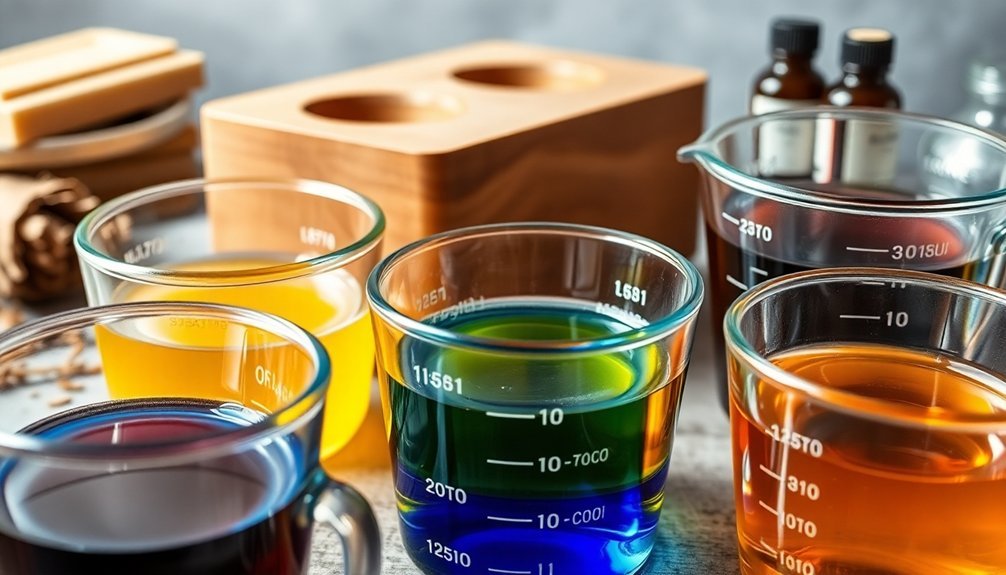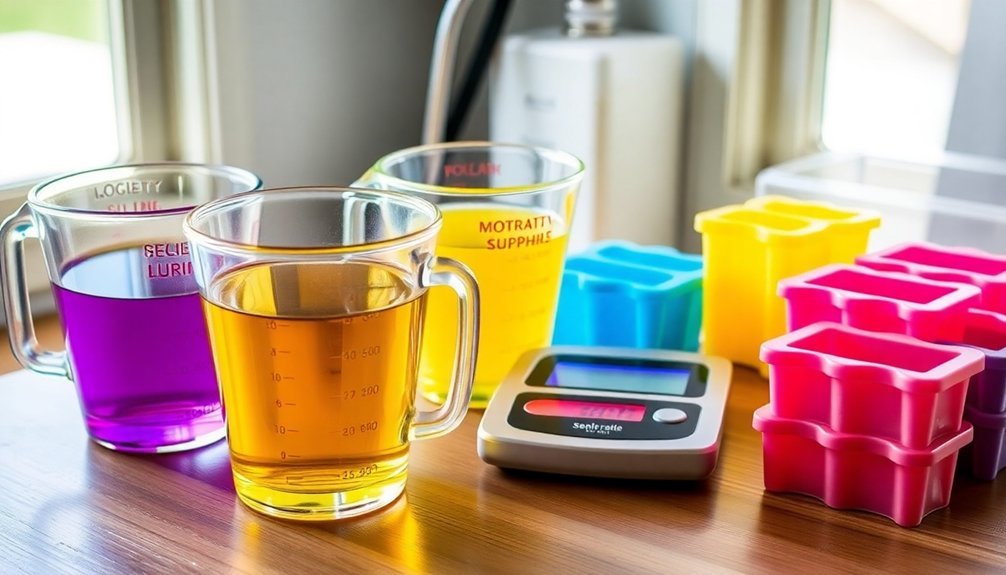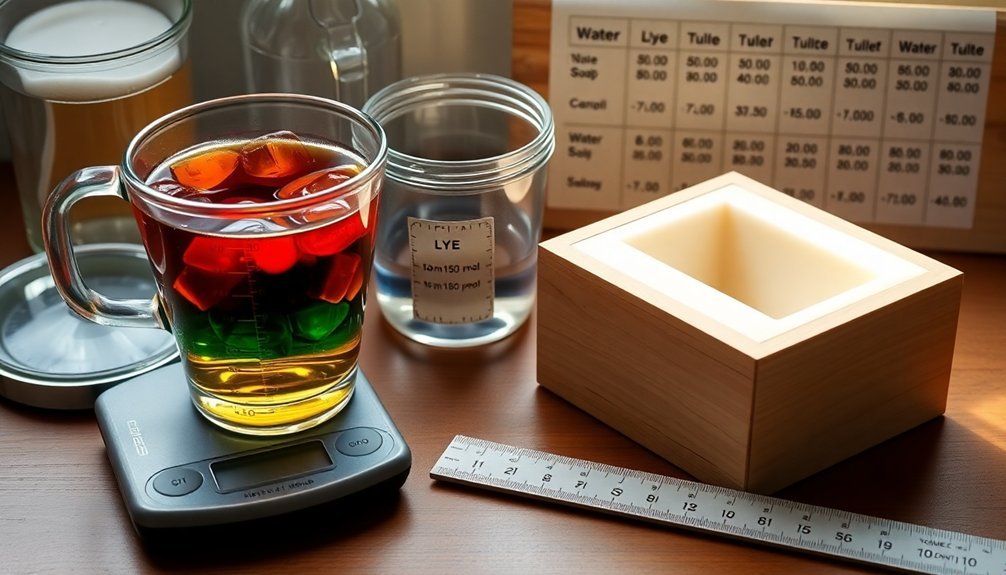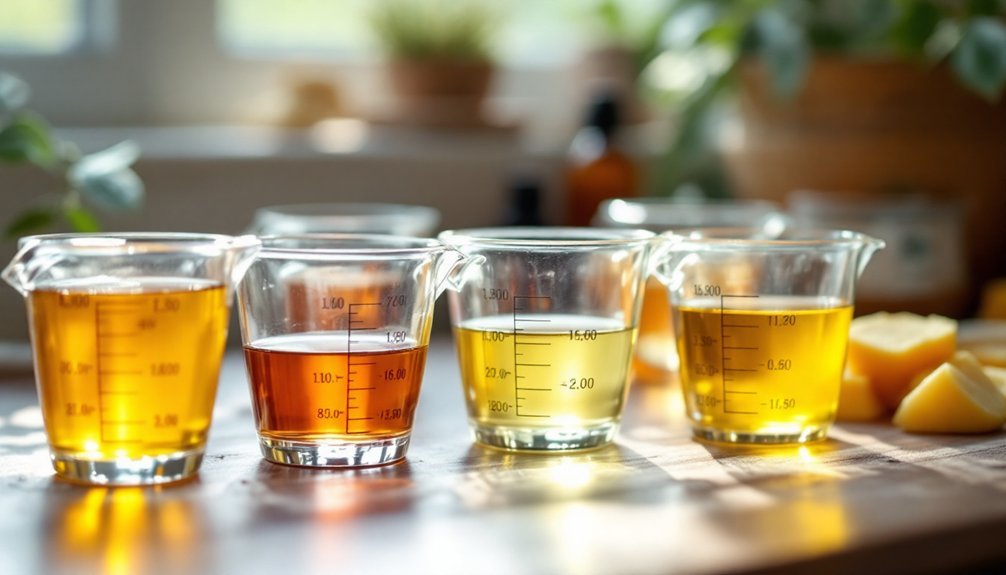In soap making, you can't rely on volume measurements as they're imprecise. Different oils have varying densities, meaning 1 fluid ounce doesn't equal the same weight across ingredients. For example, 8 fluid ounces of coconut oil weighs about 6.7 ounces, while other oils differ. Always use a digital scale for accuracy, measuring ingredients by weight. Your soap's quality and safety depend on precise measurements that volume simply can't provide.
What Volume Measurements Convert To In Soap Making?

While many crafters start soap making with familiar kitchen measurements, converting volume to weight is essential for consistently successful results.
Your measuring cup might work for cooking, but soap making demands precision that only weight can provide. A fluid ounce of coconut oil doesn't weigh the same as a fluid ounce of water due to differences in density.
Leave your measuring cups in the kitchen—soap making requires a scale where oils and water can't hide their true weights.
This is why experienced soap makers rely on weight measurements rather than volume. For accuracy, use a conversion calculator or soap calculator to transform volume measurements to ounces by weight.
Remember that 1 fluid ounce equals approximately 29.57 milliliters, but the weight will vary by ingredient. What weighs 8 ounces in water might weigh 7.5 ounces in oils—a difference that can notably impact your soap's quality.
Common Oil Volume-to-Weight Conversion Ratios
Since accuracy determines the success of your soap, understanding specific oil conversion ratios is essential.
When working with liquid oils, each fluid ounce typically converts to about 0.9 ounces by weight, while solid oils generally range between 0.85-0.95 ounces per fluid ounce when melted.
For practical measurement, a cup (8 fluid ounces) of common oils weighs approximately 7.5 ounces. Individual oil densities matter greatly—coconut oil, with a density of 0.92 g/ml, weighs about 0.84 ounces per fluid ounce.
These conversion ratios aren't just helpful guidelines; they're critical factors in achieving proper saponification.
When you're formulating recipes, remember that weight vs. volume measurements can make the difference between perfect soap and an unsuccessful batch. Always prioritize accurate conversions for consistent results.
Essential Measurements for Scaling Batch Sizes

Three critical conversions form the foundation for successfully scaling your soap batches.
First, remember that 1 fluid oz of water equals 28.35 grams by weight—essential when calculating the amount of lye, which should never be measured by volume due to safety concerns.
Second, convert oil measurements using the 1 liter = 33.814 fluid oz ratio, while accounting for different densities. Coconut oil, for instance, has a density of 0.92 g/ml, affecting how many ounces of soap your batch will yield.
Finally, use the 29.57 ml = 1 fluid oz conversion for precise essential oil measurements.
When scaling batch sizes, input these conversions into a lye calculator for consistent results. Common soapmaking mistakes occur when formulators overlook these volume-to-weight relationships, resulting in batches with improper saponification.
The Density Factor: Why Different Oils Weigh Differently
Understanding oil density presents a fundamental challenge for soap makers who've experienced the confusion of seeing different oils fill measuring cups identically yet weigh differently on the scale.
This occurs because oils like Coconut Oil (0.92 g/ml) have higher density than Sweet Almond Oil, making them heavier for the same volume.
When crafting soap, you'll need to weigh your oils rather than rely on volume measurements.
This precision guarantees accurate ingredient ratios for proper saponification. Since lye calculations depend on the exact weight of oils used, measuring by volume can lead to dangerous imbalances in your formula.
Remember that 8 fluid ounces of different oils won't weigh the same.
This density variation considerably impacts your soap's quality, safety, and consistency.
Practical Mold Capacity Calculations for Soap Makers

Calculating your soap mold's capacity correctly stands as a critical step that many beginners overlook. To determine the amount of oils needed, multiply your mold's volume in fluid ounces by 0.4 to account for proper soap height and prevent overflow during the process.
Proper mold calculations prevent soap-making disasters and ensure perfect bar height every time.
Remember that each oil contributes differently based on its density. For example, palm oil's 0.89 g/ml density affects your final calculations. When converting between volume and weight, use specific density values for each oil in your recipe.
Most soap making formulations list mold capacity in ounces, which helps you calculate the total weight of oils required.
Don't forget to factor in water and additives when determining volume requirements. This thorough approach guarantees your soap fits perfectly in the mold while maintaining proper formulation ratios.
Frequently Asked Questions
How to Calculate the Volume of Soap?
To calculate soap volume, measure your mold's dimensions: length × width × height for rectangular molds or π × radius² × height for cylindrical ones. You'll need these measurements when preparing your recipe for consistent results.
What Are the Measurements for Soap Making?
For soap making, you'll need a scale for weight measurements (grams/ounces) rather than volume. Weigh your oils, lye, and water precisely to guarantee consistent results. Don't rely on cups or spoons for accuracy.
What Is the Unit of Measurement for Soap?
In soap making, you'll primarily use weight (ounces) as your unit of measurement. It's more accurate than volume measurements, ensuring your soap recipes maintain consistent ratios of oils, lye, and other ingredients for successful results.
How to Calculate How Much Soap Mold Volume?
To calculate soap mold volume, convert the total weight of your oils to volume. Divide oil weight by the oil's density (typically 1 oz ≈ 1 fluid oz). Consider adjusting by a fill factor of 0.4 for proper height.
In Summary
You'll find mastering weight conversions essential to your soap making success. By understanding that different oils have unique densities, you're better equipped to scale recipes accurately. Remember, volume measurements are convenient but weights provide precision. Keep your conversion chart handy and invest in a good digital scale. With practice, you'll intuitively know how much your molds can hold and create perfectly sized batches every time.





Leave a Reply